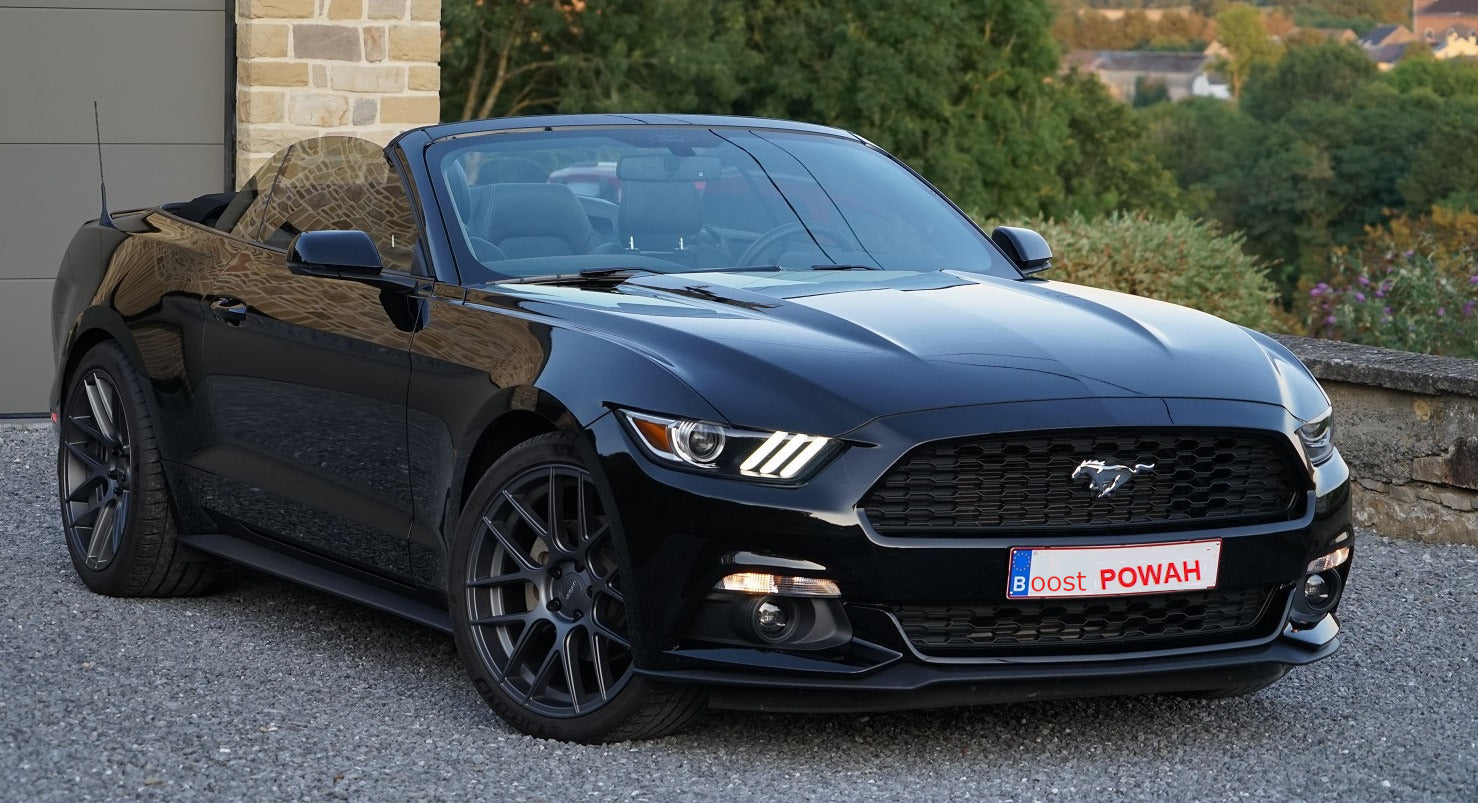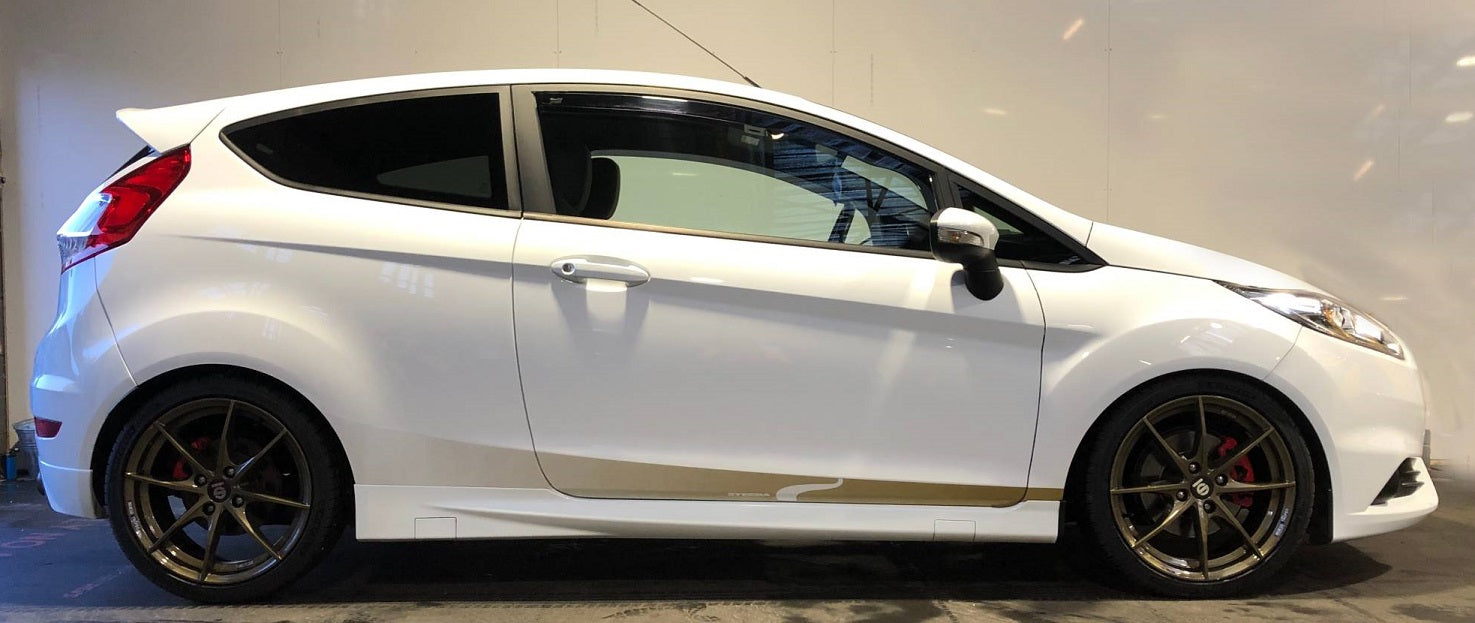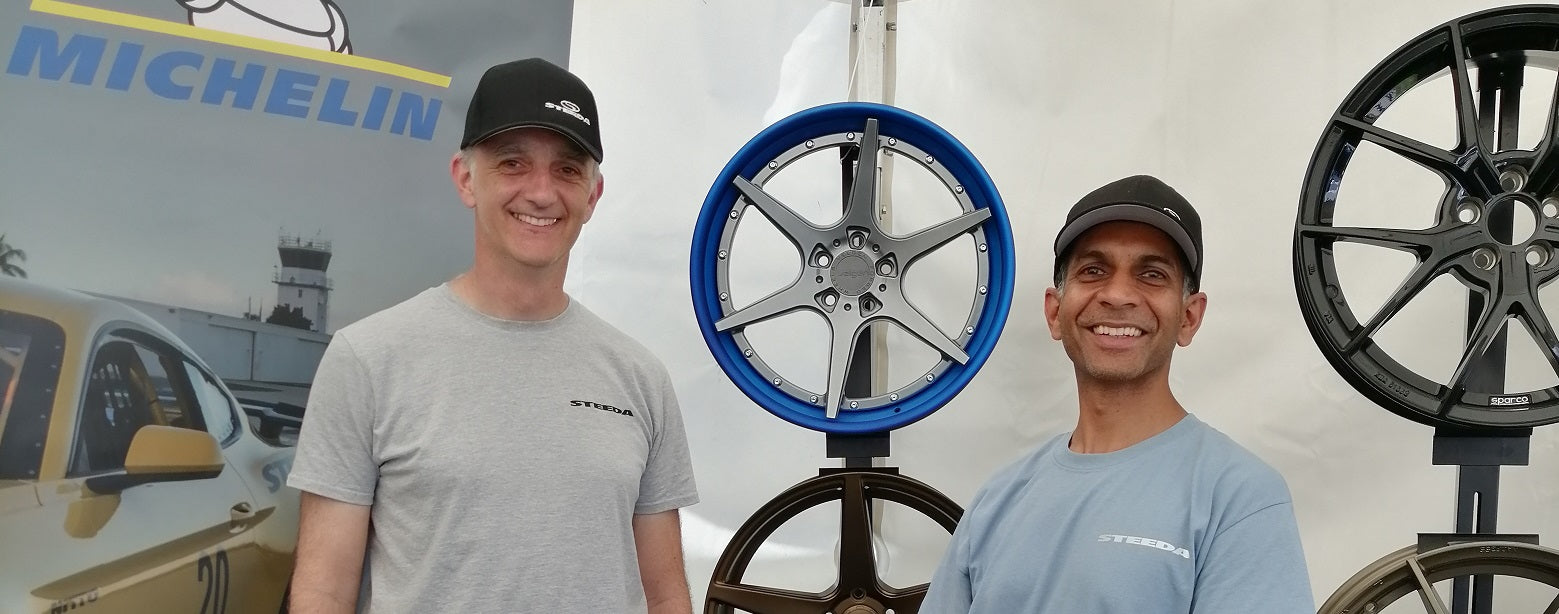
Mustang Ecoboost 2.3 (S550) Ultimate Tuning Guide - "BOOST ME!" Part 1
Mustang comes with two powertrains in Europe, the classic V8 but also the 2.3 litre 4 cylinder turbo charged gem that is part of Ford's EcoBoost range of engines, from the teeny weeny 1.0 litre all the way up to the big boy of the line, powering the ferocious GT, the 3.5L Twin Turbo V6 (hnnng!).
There are those who think only GT's count, but at Steeda we know they are wrong. The Ecoboost has merits all of its own, in both economic AND performance terms.
You see the Ecoboost brings two performance tricks to the table.
1. Weight. That's right. The EcoBoost system is nice and light. An Ecoboost Mustang is around 75 KG lighter than a GT, and that [non]weight is dangling over those front wheels, which means the Ecoboost is easier to stop on its brakes, sharper on turn in and suffers less momentum in direction changes at the front end. All valuable assets when we are talking about performance driving. And at Steeda we know "Speed Matters"
2. Turbos. Snails. Turbskis. Boost Boys. The heart of the EcoBoost is the BOOST side of things. A turbo means easy tuning. You don't need to invest in a big money forced induction system like GT owners do, as YOU ALREADY HAVE ONE! Woo! We just need to make it better, and this guide can give you some tips on how to do so.
Power Basics:
Now as we know, power in petrol driven cars comes from combining fuel and air and exploding them in our engines. To make MORE POWER! we need to add more fuel and air in the appropriate amounts, and a few things make this easier.
1. AIR:
This simple but vital ingredient to keep our engine happy and performing at its best is a tricky thing. We can help it come in with an efficient and effective AIR INTAKE system, like the ones we offer from Steeda and CP-E.
The idea of an intake is to allow more air to flow more easily into your engine, and also to try and prevent the effect of 'heat soak' which is why sealed units like the Steeda and CP-E intakes are often called "Cold Air intakes". Intakes which just have an exposed filter can suck in hot air from the engine and as we shall see later, hot air is the enemy of performance.
The next picture shows how the Steeda intake is both smoother and a bigger bore all the way down to the actual engine intake. The smoothness from having no ribbed rubber hose at the top and funny shape at the bottom means less turbulent air flow which means the air flows more easily into the engine.
Now what goes in to an engine (air!) must also come out as exhaust gas and if your exhaust is not flowing efficiently then that too will restrict your engine's ability to efficiently make optimal power. This is called "back pressure" and on turbo driven cars which are powered by the exhaust running effectively, back pressure can be the enemy of smooth running.
Turbos are powered by your car's exhaust energy to spin the turbo, which in turn spins a compressor wheel to suck in the air for the engine. Back pressure can slow down the turbos response as the incoming exhaust which wants to spin the turbo fights against the pressure caused by the exiting gas which wants to stop the turbo spinning. Hence "back pressure". So an efficient exhaust system will not just allow a boost in power but also a boost in turbo responsiveness as it allows easier / faster turbo spooling.
In turbo cars, exhausts can be divided in to catback / axle back systems, which simply mean the back end of the exhaust, from either the catalytic converter (cat) or just the rear end section from behind the rear axle, and the "down pipe" which comes from the turbo 'down' to the rear section. As we are talking about power though we will discount axle back systems which are more about sound and looks than power.
We can provide a variety of system but recommend either the CP-E system or if you want an EC Certified system, the resonated Milltek system, which comes in a nice variety of tip finish options. You can normally add an intake and a catback with no need for a supporting tune (also known as an ECU remap). The ECU (Engine/Electronic Control Unit) is the electronic brain which controls your entire car, and makes sure the balance between air and fuel is working to produce optimal power.
You can normally add an intake and a catback with no need for a supporting tune (also known as an ECU remap). The ECU (Engine/Electronic Control Unit) is the electronic brain which controls your entire car, and makes sure the balance between air and fuel is working to produce optimal power.
Adding a downpipe to a car usually means a tune is required as the increase in flow can be so dramatic the engine cannot efficiently deal with the change without some help. Down pipes usually come in "high flow cat" or decat / race versions and for road use you will need a catted version.
2. TUNING
That's why adding a tune to a car, especially a turbo charged car like the EcoBoost Mustang can really enhance performance, as the tune can be optimised to prioritise performance, taking advantage of both hardware enhancements (to optimise air flow) and the owners commitment to performance (by which we mean adding high octane fuel and maintaining their car in peak condition!).
The computer is concerned with optimising the mixture of your air and your fuel.
You may have heard of AFR (Air Fuel Ratio) and the computer is designed to try and run near the optimal mixture which is roughly 14 units of air to 1 of fuel. A perfectly optimised mixture which results in a burn leaving nothing left over is known as a stoichiometric mixture (referred to as "stoich" sometimes), and if the mixture leaves left over fuel unburnt, it is referred to as "Rich" and if there is air left over unburnt, it is referred to as "Lean" mixture or running lean.
Now running rich is preferable, as leftover fuel provides a number of benefits....
a.. It adds a margin of safety for your engine (if the fuel was not of the quality expected for example)
b. It offers cooling, which helps prevent detonation, unlike running lean which causes higher temperatures which in turn can increase the risk of detonation.
Detonation is when the explosion caused by mixing fuel, air and a spark happens before you want it to happen and it can be fatal to your engine.
Think of your engine, happily turning at 5,000 revolutions per minute, with each mini explosion happening in each cylinder at just the right time, helping to push the engine "forward" . Suddenly an explosion (or series of explosions) happens at exactly the wrong times, trying to force the engine to stop by pushing the cylinder "the wrong way". It won't like it and can result in all kind of problems, upto and including shooting parts of your engine across the street...
Minor detonations can cause no harm, and are known as "pinking" but they are certainly a warning that things are not well and its time to ease off the throttle ASAP and then get the car in for a health check.
STEEDA TIP: Detonation (or "misfires") are not solely caused by tuning as some people think... Once they have tuned their car they can sometimes believe any issue is the fault of the tune....
Problematic running can be caused by a huge range of issues...bad fuel, a bad spark plug, an air leak, these are all common problems. A tune can only run optimally,on an optimally running car.
3. FUEL
We mentioned fuel, and detonation, and cooling and ECU tuning and AFRs. Fuel needs to be consistently high quality to allow a tuner and engine to run at peak efficiency and with a focus on power. When running a tuned car, always run the highest octane possible from your local pumps. There is no point spending money on all the hardware and a tune and then running cheap fuel.
While octane rating is confusing, the simple explanation is that higher octane equals more resistance to detonation and more control for the engine tuner.
4. TEMPERATURE / HEAT
So far so simple right? Well this is where things get a little more complex, especially with turbo cars. In NA cars (Naturally Aspirated) the engines breathe in air at atmospheric pressure and it rolls in as fast as they can suck it and shoot out the back once burned up. In FI cars (Forced Induction) the poor air molecules aren't left to their own devices but forced into the engine as fast as the turbo charger or supercharger can make them...
This is what is known as boost, as the engines ability to take in air is "boosted" by the FI system, and its usually measured in pressure like PSI (Pounds per Square Inch) or BAR (Barometric pressure) or, less commonly, KPA (KiloPascals).
These should all take into account atmospheric pressure which is roughly 14.7 PSI or 1 BAR at sea level. So "Boost" would be any pressure over atmospheric pressure, so a turbo showing 8 PSI of boost would mean it is 8 more than atmospheric.
Air doesn't like being hassled (and nor do any of us...) and just like us, when it gets forced around it can get a little heated. If pushed around a lot (by a higher boost turbo for example) it gets even more heated. And when air gets heated, it expands. This results in this....
 As we can see, having big unhappy boosted air means our mixture isn't right, as we can only fit 6 units of air into the cylinder, not 14 to mix with our fuel... so what do we do?
As we can see, having big unhappy boosted air means our mixture isn't right, as we can only fit 6 units of air into the cylinder, not 14 to mix with our fuel... so what do we do?
This is where the intercooler comes into turbo charged systems. The intercooler takes the big hot air which comes out of the turbo and cools it back down allowing us to ruthlessly stuff MORE air and so also allow MORE fuel into the cylinder without risk of detonation and make us a nice bunch of boosted power.
The stock intercooler is designed to be ok for road use but as soon as performance tuning or track use comes into the mix (where constant full throttle action can result in heat build up) it rapidly gets out of its depth.
As soon as the ECU detects hot angry air getting into the engine and compromising our lovely 14:1 AFR it will start to defensively pull back performance in order to prevent detonation, causing power loss.
This is why addressing power without addressing cooling in FI cars is a huge (but common!) mistake.
CP-E make two intercooler options, one for a normal road / occasional track day use for a tuned and upgraded car, and a hardcore "big unit" intercooler for a track focussed car or one aiming for big power. The normal unit should be ample for most user and offers a huge boost in performance over the stock factory intercooler.
Summary of the basics
This "trinity" of modifications and upgrades, for air flow, cooling and tuning will provide the basis of any effective ecoboost tuning and we can of course supply all that you need. and once addressed we can also supply further improvements to help you perfect the performance (and look) of your car.
We highly recommend the Velgen VF5 Lightweight wheels range as not only do they look amazing but the lightweight wheels aid performance in all aspects, and will also further enhance the weight advantage your Ecoboost stang already has.
Turbo accessories like Steeda or Turbosmart bypass or blow off valves will increase the longevity and durability of your systems, as well as add some turbo drama sound track if you want a BOV (Blow Off Valve) which vents to atmosphere rather than a Bypass / Recirculating Valve which returns the air into the intake system.
The stock valves are made of plastic and are quite weak, especially if running increased boost through tuning. Believe me when I say, a factory plastic valve exploding at 110 MPH on the back straight of a track (as happened to me once) is no fun at all.... The valve wasn't all that needed changing afterwards....

Further Steps:
The above gives a great start on the road to EcoBoost tuning and will result in a really nicely improved car, and as a bonus things like an improved intercooler can mean that on daily driving the car runs cooler and more efficiently, meaning better MPG. The same with lightweight wheels, as well as adding performance they add efficiency.
Taking things further, you have a couple of options:
- Upgrading things like your intercooler pipework with whats known as a "hardpipe" kit to further optimise flow and performance of the intercooler system.
- Swapping the turbo and downpipe with a larger kit such as those provided by CP-E.
- Adding water /meth kits to further reduce charge temps and prevent detonation...
However this blog is only about starting steps!
Steeda Europe Top Tip:
Please note that while the EcoBoost is a great engine it wasn't designed to be able to tolerate huge boosts in power, so going further than basic upgrades as mentioned or shooting for big numbers over 450hp, serious thought should be given to investing in a block enhancement prior to taking things further, so you can enjoy your "part 2" modifications rather than sweating about your engine failing every time you stamp on the throttle and watch that boost build!
Don't forget that power is nothing without control, so make sure you compliment any power enhancements with Steeda suspension! But that's another blog post!
Have a browse on our EcoBoost Mustang shop and of course never hesitate to ask for help or advice.



